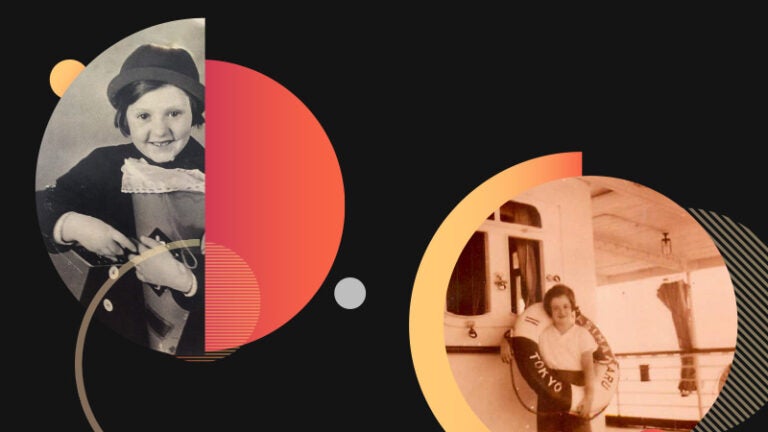
Holocaust separates childhood friends; USC Shoah Foundation reunites them
Ilse Grebenschikoff and Anne Marie Wahrenber saw each other for the last time in the spring of 1939, exchanging tearful farewells in a Berlin schoolyard. Shortly afterwards, their families fled Germany, driven out by the escalating violence of the Nazi regime. Both were only 8 years old.
Impending doom had become increasingly apparent for Berlin’s Jewish community in the months leading up to their departure. During a single night in the fall of 1938, thousands of Jewish businesses were destroyed and 30,000 Jewish men arrested, an event later known as “Kristallnacht,” or “night of broken glass,” after the glittering shards of glass that littered the city in the aftermath.
Wahrenberg’s father was one of those arrested and sent to a concentration camp, where his hair tuned white from the shock. He escaped, but the family knew they may not be so lucky again.
In the spring of 1939, Wahrenberg and her parents departed for Chile. The Grebenschikoffs headed to Shanghai. After that final farewell in the schoolyard, the two girls lost all contact with each other for the next 80 years.
They remained on each other’s minds, however. In 1997, Grebenschikoff recorded testimony about her Holocaust experience for the USC Shoah Foundation — The Institute for Visual History and Learning. In her testimony, she mentioned Wahrenberg: “I never knew what happened to her, and I’m always wondering if maybe she’s somewhere, and can hear this.”
Another few decades later her words, and a skilled archivist at the foundation, would bring the two together again.
Lost but not forgotten

Betty Grebenschikoff, left, and Anna María Wahrenberg, talk online after being reunited by the USC Shoah Foundation. (Photo: Courtesy of USC Shoah Foundation.)
Prior to their separation, Wahrenberg and Grebenschikoff had been the best of friends, attending the same synagogue and taking ballet lessons together. The Nazi party forbade Jews from going to swimming pools or theaters, so the girls spent a lot of time playing in their rooms together.
“We ate too much candy because Ana María insisted that if we put our feet up on the table then we would not get sick,” says Grebenschikoff. “Our mothers soon put a stop to that maneuver.”
Even after their separation, their lives paralleled each other. Both settled in foreign cities, married and raised tight-knit families.
Grebenschikoff’s family landed first in Shanghai, where food and shelter were scarce, but the situation was still preferable to the alternative — almost all of her extended family was killed in the Holocaust.
During China’s Communist uprising, the country became unwelcoming towards outsiders, and Grebenschikof had to flee again — this time while pregnant. She and her husband eventually settled in Atlantic City, New Jersey, having five children, seven grand-children and six great-grandchildren.
Wahrenberg stayed in Santiago, Chile, where the family had initially found sanctuary, learned Spanish and married. She raised two children and is grandmother to six and a great-grandmother to 10. Her entire extended family was also killed in the Holocaust.
The two even do the same volunteer work, helping at their local Holocaust museums and presenting their wartime experiences to schoolchildren.
Both women spent considerable time over the decades attempting to track down their long-lost friend in databases of Holocaust survivors. With the passage of time, however, much about their identities had changed. Neither used their maiden names anymore, and each changed their first names: Grebenschikoff now went by Betty instead of Isle, and Wahrenberg changed her first name from Anne Marie to Ana María. Eventually, both began to wonder if the other might have perished in the Holocaust just like most of their relatives.
The archivist with an intuition
More than 80 years after the women separated, Ita Gordon, the archivist at the USC Shoah Foundation, logged into a virtual presentation on Kristallnacht hosted by the Jewish Interactive Museum of Chile. Survivors of that night were invited to speak about their experience, including Wahrenberg.
Gordon’s ears pricked up when Wahrenberg mentioned her lost friend during the talk. “There was a voice in me that said to help,” says Gordon. “She became my inspiration. She stayed with me.”
Immediately after the call, Gordon put her two decades of experience to work. She scrutinized the USC Shoah Foundation records for clues, typing Wahrenberg’s name into the database along with the name of the synagogue they both attended, as well as their primary school.
“It took tenacity and patience, but it’s easier if you’re inspired,” Gordon says.
She eventually got a hit: Grebenschikoff’s 1997 foundation testimony in which she mentioned her lost friend “Anne Marie.” Gordon’s intuition kicked into high gear. Additional meticulous research soon confirmed that Ana María Wahrenberg was indeed the “Anne Marie” that Grebenschikoff sought.
History of life
The foundation contacted Grebenschikoff and Wahrenberg in December 2020 to arrange a video meeting, and a few weeks later, the two women reunited. Surrounded by their extended family, it took only a few minutes for the duo to hit it off again.
“Even after all these years, it feels like we never stopped talking,” says Wahrenberg.
For Stephen Smith, Andrew J. and Erna Finci Viterbi Endowed Executive Director Chair of the USC Shoah Foundation, the reunion is proof of the importance of the foundation’s records.
“These kinds of connections are possible because the 55,000 people who gave testimony named millions of people and places,” says Smith. “People now, and into the future, can search this powerful resource to learn about their own families and the people and places of their past — to truly understand who they are.”
Gordon has worked in the archives for 20 years and counts this reunion as an exceptional example of the power of the USC Shoah Foundation.
“I have many stories, but this is different. It’s very unusual for me. They both have the gift of life,” says Gordon. “This shows there can be happy endings after all.”